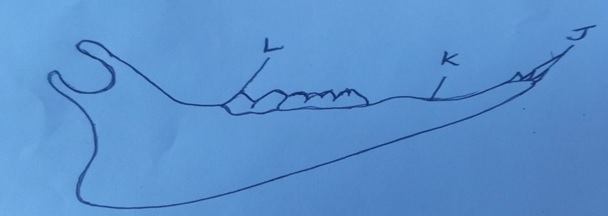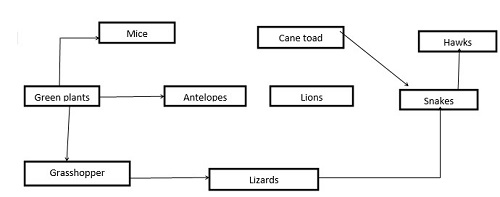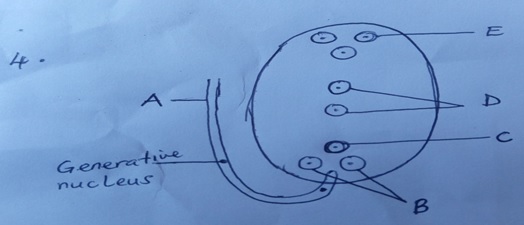Question 1
The diagrams below represents two plants cell A and B placed in two different solutions. Study the diagrams and answer questions that follow.

a) Identify the nature of solution into which each cell was placed.
A
B
b) Name the physiological process responsible for the observed results.
c) Give the correct biological term used to describe cell A.
d) Describe what would happen if a red blood cell was placed in the solution in which cell B was placed.
e) Explain why freshwater amoeba do not burst when placed in distilled water.
f) Explain the fate of glucose after assimilation
Answer
a) - Hypertonic.(highly concentrated solution)
- Hypotonic.(lowly concentrated solution)
b) Osmosis
c) Plasmolysis
d) It will gain water by osmosis, swell and eventually burst.
e) Form contractile vacuoles; which get rid of excess water.
f) Oxidized to produce energy or converted to glycogen for storage.
- Hypotonic.(lowly concentrated solution)
b) Osmosis
c) Plasmolysis
d) It will gain water by osmosis, swell and eventually burst.
e) Form contractile vacuoles; which get rid of excess water.
f) Oxidized to produce energy or converted to glycogen for storage.
Question 2
a) Distinguish between the terms homodont and heterodont.
b) What is the function of carnassial teeth?
c) The diagram below represents the lower jaw of a mammal.

i) Name the mode of nutrition of the mammal whose jaw is shown above.
ii) State one structural and one functional differences between the teeth labeled J and L.
iii) Name the toothless gap labeled K.
iv) State the function of the gap.
v) Name the substance that is responsible for hardening of teeth.
vi) What do you understand by the term ‘dental formula’.
Answer
a) Homodont is a situation where an organism has teeth of same sizes and shapes while Heteredont is a situation where an organism has teeth of different sizes and shapes.
b) - To slice through flesh and crush bones.
c) i) Herbivore
ii)
iii) K - diastema
iv) Assist in turning of food during grinding
v) Calcium phosphate and carbonate.
vi) Dental formula - It’s the description of the number, type and position of teeth in the jaws of mammals.
b) - To slice through flesh and crush bones.
c) i) Herbivore
ii)
| J | L | |
|---|---|---|
| Sracture | flat, chisel shaped | broad, ridged surfaces |
| Function | cutting and biting food | crushing and grinding food |
iii) K - diastema
iv) Assist in turning of food during grinding
v) Calcium phosphate and carbonate.
vi) Dental formula - It’s the description of the number, type and position of teeth in the jaws of mammals.
Question 3
The diagram below represents a food web in a terrestrial ecosystem.

a) Which organism has the highest number of preys?
b) Construct food chains with snakes as tertiary consumers.
c) State the trophic level occupied by hawks in the food chains constructed in (b) above
d) Describe how capture-recapture method can be used in estimating the population of fishes in a lake.
Answer
a) Hawks
b) Green plants → grasshoppers’ → lizards → snakes → hawks,
Green plants → mice → cane toads → snakes → hawks
c) Quaternary consumers
d) Capture some fish, mark and release them. Record as first marked (FM), after 24 hours, collect as many organisms as possible in the same area. Record the number collected as second capture. (SC). Record the number of those previously marked as marked recaptured (MR).
b) Green plants → grasshoppers’ → lizards → snakes → hawks,
Green plants → mice → cane toads → snakes → hawks
c) Quaternary consumers
d) Capture some fish, mark and release them. Record as first marked (FM), after 24 hours, collect as many organisms as possible in the same area. Record the number collected as second capture. (SC). Record the number of those previously marked as marked recaptured (MR).
Question 4
Name the process through which;
a) Producers convert chemical energy into heat energy lost to the environment.
b) Living organisms convert chemical energy into heat energy lost to the environments.
Answer
a) Photosynthesis
b) Respiration
b) Respiration
Question 5
The figure below shows the embryo sac before fertilization.

a) Identify the structures labeled A and B
A
B
b) Identify the structures labeled in the diagram that will develop into the following after fertilization.
c) State the ploidy of each of the following nuclei after fertilization
i. C
ii. D
Answer
a)
A - Pollen tube
B - Synergids
b) (i) Embryo zygote
(ii) Endosperm - Primary endosperm
c) i. C - Diploid
ii. D - Triploid
B - Synergids
b) (i) Embryo zygote
(ii) Endosperm - Primary endosperm
c) i. C - Diploid
ii. D - Triploid
